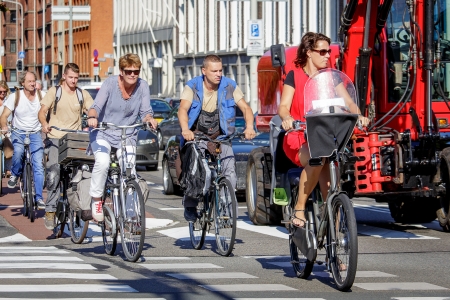An observational study in December 2021 and January 2022 [39] shows that 86.8% of cyclists had functioning front lights, and 81.5% functioning rear lights. More than three quarters (78.3) were using both lights. Young and young adult cyclists comparatively less often had lights than older cyclists. Cyclists on regular bicycles used lights clearly less often than on pedelecs or speed pedelecs. Although, in the four major cities (Amsterdam, The Hague, Rotterdam and Utrecht) the use of lights had increased since the previous measurements (from 67% to 73%), it was still significantly lower than in other cities (80%).
Since 2003, these observational studies commissioned by Rijkswaterstaat (Department of Waterways and Public Works) have regularly been repeated in winter months. In December 2021 and in January 2022, over 14,500 cyclists were observed at dusk (3 – 26 lux) and in the dark (< 3 lux). As is shown in Figure 4, bicycle lighting has considerably increased in the last two decades. According to organisations BOVAG and RAI this is due to the fact that more and more bicycles come equipped with automatic lighting [40].
Figure 4. Percentage of cyclists using front lights, and percentage of cyclists using rear lights (2003-2021/2022). Source: [39].
Regulations
Cyclists are legally obliged to use front and rear lights in the dark and when visibility is poor. The front light must be white or yellow and the rear light red, and the lights must shine straight ahead or straight backward and must not blink [41]. Since 2008, lights that are not attached to the bicycle but to the cyclist’s upper body, for example to a coat sleeve, have also been allowed. The observational study by Timmermans, Prey & Laurens [39] shows that 99% of the cyclists using lights have both front and rear lights attached to their bicycles, which means body lights are not often used.
In addition to front and rear lights, bicycles must be equipped with a red reflector on the rear side, white or yellow reflectors on the wheels or tyres, and (amber) yellow reflectors on the pedals.
Road safety effect
To what extent, properly functioning bicycle lighting enhances cyclist safety is not well-known.
In 2021, the Traffic Psychology Group of the University of Groningen was commissioned by Rijkswaterstaat to conduct a literature review of the visibility effects of new forms of lighting and reflection for bicycles and/or cyclists [42]. The researchers concluded that it cannot be determined that new developments concerning lighting and/or reflection - for example wheel lighting, helmet lighting, spoke reflection, or safety vests – significantly contribute to faster or earlier detection of cyclists, provided they were already using the currently mandatory lighting.
Kuiken and Stoop [43] have calculated that the share of cyclist injury crashes in the dark will decrease by 0.17% when the use of bicycle lighting increases by 1%. This indicates a positive effect of bicycle lighting, but the researchers indicate that the outcome is too uncertain to reliably estimate the extent of the effect. They also say that the estimate is based on registered crashes which, thus, only concerns the effect on bicycle crashes involving motor vehicles. After all, bicycle crashes not involving motor vehicles and single-bicycle crashes are rather poorly registered. On the basis of self-reported behaviour and self-reported crashes as measured in periodic regional road safety research, the researchers have found a slightly increased risk of a single-bicycle crash and a larger increased risk of a multiple crash for cyclists saying they only sometimes or hardly ever use bicycle lighting. It cannot be excluded that cyclists that do not use lights may also differ from cyclists that do use lights in other relevant ways. Therefore, it is uncertain whether the effects mentioned above can be attributed to the bicycle lighting itself.
